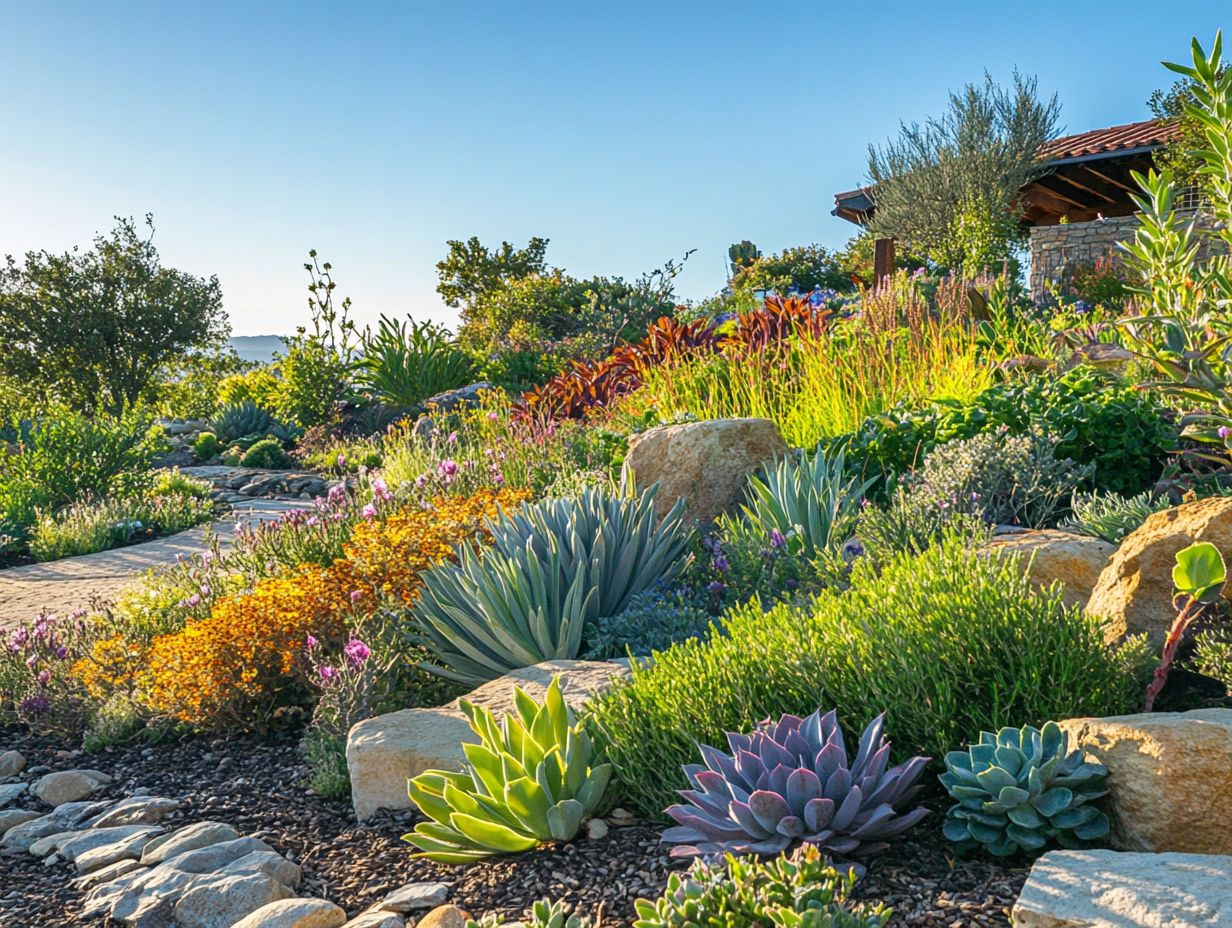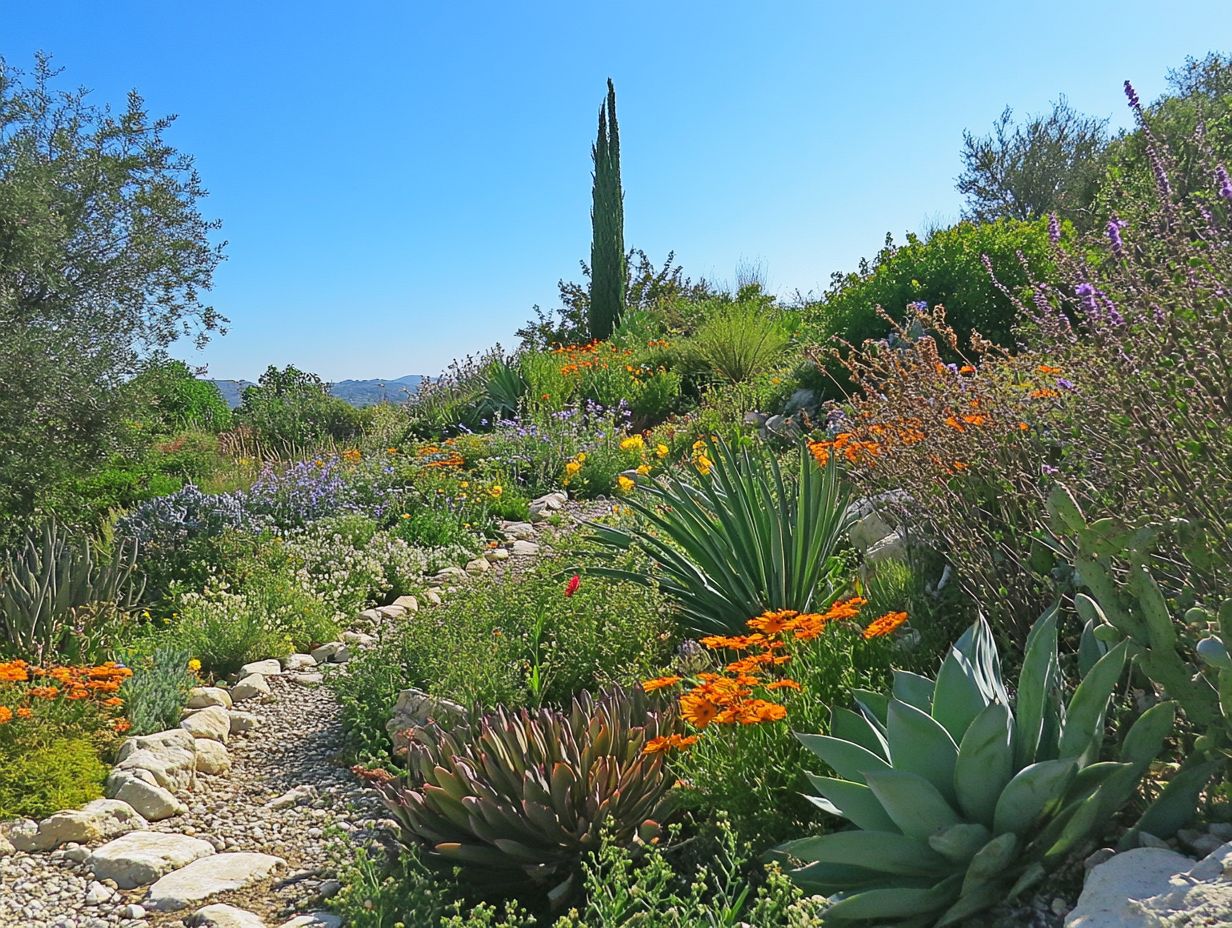The Future of Drought-Resistant Gardening
As climate change intensifies, you might see more droughts affecting your garden, presenting big challenges for gardeners like yourself, especially in areas facing heat domes and limited resources.
This article delves into the effects of drought on plants, comparing traditional gardening methods with innovative, drought-resistant techniques, including xeriscaping a method of gardening that reduces the need for watering and the use of water-wise plants.
You ll uncover strategies for cultivating a thriving garden that flourishes even in arid conditions. This includes selecting resilient plants, employing water conservation techniques, and supporting local wildlife.
We’ll also showcase the latest technologies and innovations designed to enhance water conservation, particularly through garden design that promotes sustainable gardening.
Dive in to discover how you can adapt your gardening practices for a sustainable future.
Contents
- Key Takeaways:
- The Impact of Drought on Gardening
- Traditional Gardening vs. Drought-Resistant Gardening
- Strategies for Creating a Drought-Resistant Garden
- Technology and Innovation in Drought-Resistant Gardening
- Frequently Asked Questions
- What is drought-resistant gardening and why is it important for the future?
- How does drought-resistant gardening benefit the environment?
- What are some popular plants for drought-resistant gardening?
- Are there any special techniques for drought-resistant gardening?
- How can I start implementing drought-resistant gardening in my own backyard?
- Is there a movement towards more sustainable gardening practices like drought-resistant gardening?
Key Takeaways:

- Drought can seriously harm your garden, leading to plant damage and water scarcity.
- Drought-resistant gardening offers many benefits, such as saving water and lower maintenance.
- Using drought-resistant plants and smart watering techniques can help you build a thriving garden.
The Impact of Drought on Gardening
Drought profoundly influences your gardening endeavors, presenting big challenges for plant growth, especially in areas grappling with climate change and drought conditions. As water becomes increasingly scarce, you must adapt your practices to safeguard your plants’ survival.
Prioritizing drought-tolerant and drought-resistant species that thrive on minimal water is essential. For those interested in the latest developments, exploring emerging trends in drought-resistant plants can help save water and support sustainable gardening principles, enhancing the beauty and ecological health of your garden.
By doing so, you cultivate a natural environment around us that can flourish under limited resources, supporting local wildlife and promoting biodiversity.
Understanding the Effects of Drought on Plants
Drought conditions can impose significant stress on plants, leading to reduced growth, wilting, and even death, particularly for those that lack drought tolerance and are not adapted to seasonal changes.
This stress intensifies in poor soil conditions, where insufficient moisture threatens plant life and leads to erosion, further undermining the ecosystem’s health.
On the other hand, native and drought-resistant plants, such as Acacia and Palo Verde, possess remarkable adaptations that allow them to endure extended dry periods. With deeper root systems that tap into underground moisture, and waxy leaf surfaces that minimize evaporation, they are well-equipped to thrive in arid environments.
As these resilient plants flourish, they play an essential role in maintaining soil integrity, preventing erosion, and supporting local wildlife, which contributes to habitat creation and outdoor green space. Choosing the right plants for your area helps the ecosystem.
Traditional Gardening vs. Drought-Resistant Gardening
Traditional gardening tends to depend on a steady water supply and often overlooks drought-resistant techniques, failing to incorporate the principles of xeriscaping. In contrast, drought-resistant gardening uses smart strategies that conserve water and highlight the beauty of native plants.
This approach enhances the aesthetic appeal of your garden and positions you as a steward of sustainability, especially in a time of climatic shifts and increasing environmental responsibility. By choosing drought-resistant methods, you are making a conscious choice for a more resilient garden. For more insights, check out the best resources for drought gardening, contributing to garden sustainability and ecosystem health.
Key Differences and Benefits

The key differences between traditional gardening and drought-resistant gardening revolve around plant selection, water usage, and their respective impacts on ecosystem health. This includes biodiversity in your garden.
Drought-resistant gardening emerges as a more advantageous choice, promoting biodiversity and supporting vibrant pollinator gardens. For those interested in staying informed, exploring future trends in drought gardening can enrich the landscape design.
By choosing drought-resistant plants, you can boost soil health. These resilient species typically require less irrigation, reducing soil erosion and enhancing nutrient retention. This ensures a healthy environment for plant care. Such practices create homes for various wildlife, contributing to a thriving ecosystem.
Gardening education is essential in this transition, enabling you with the knowledge to make informed choices about sustainable practices. Local nurseries play a pivotal role, providing a wide array of drought-tolerant plants and resources, including financial funds, to help you create resilient gardens that flourish in the face of climate challenges.
Strategies for Creating a Drought-Resistant Garden
Creating a drought-resistant garden demands thoughtful planning and effective garden design. Concentrate on water conservation techniques, carefully select plants that thrive in arid conditions, and apply landscaping methods that reduce water use to enhance landscape beauty.
This approach dramatically enhances the overall design of your garden while ensuring sustainability in challenging environments.
Choosing Drought-Resistant Plants
When selecting plants for your drought-resistant garden, it s essential to opt for native species, such as Ironwood and Eryngium, which are naturally attuned to your local climate. These plants require less water and provide significant advantages for sustainable and low-water gardening practices.
By incorporating these resilient varieties, you conserve precious water resources while cultivating a vibrant landscape that benefits local wildlife. For example, certain native succulents, grasses, and flowering plants, like Big Bluestem and Russian Sage, thrive with minimal irrigation, creating inviting habitats for pollinators such as bees and butterflies.
This not only enhances the ecological health of your area but also elevates the aesthetic appeal of your garden. Choices like lavender or echinacea draw in beneficial insects and provide stunning blooms that infuse color and vitality into your outdoor space.
By emphasizing ecological balance, these plants blend effortlessly with their environment while championing sustainability.
Effective Watering Techniques
Adopting effective watering techniques is crucial for conserving water in your drought-resistant garden, especially during periods of extreme drought. Proper plant care ensures long-term survival and helps adapt to climate variations and seasonal changes.
In this context, you can employ various innovative methods to significantly reduce water waste, supporting environmental sustainability. For instance, using drip irrigation delivers water directly to the plant roots, minimizing evaporation and runoff. This enhances your overall garden design.
Implementing rainwater harvesting systems lets you capture and store rain for later use, providing a sustainable water source during dry spells. Mulching is a valuable practice that retains soil moisture, reduces weed growth, and supports soil health, preventing soil erosion. By integrating these water management strategies, you can create resilient landscapes that thrive even under changing climatic conditions, ensuring that every drop truly counts.
Start planning your drought-resistant garden today to enjoy its many benefits!
Other Considerations for Drought-Resistant Gardening

In your journey to implement drought-resistant gardening, it’s essential to go beyond merely choosing drought-tolerant plants and effective watering techniques to include community programs and conservation efforts. Understanding the benefits of drought-resistant gardening can also enhance your approach. Factors such as soil health, habitat creation, and community programs are important in elevating your gardening efforts to success.
Understanding soil health is paramount for creating a sustainable environment. Nutrient-rich, well-structured soil not only boosts the resilience of your plants but also cultivates a thriving ecosystem. Healthy soil acts as a reservoir, holding water and essential nutrients that enable your plants to endure challenging drought periods.
Community programs play a significant role by teaching residents how to garden sustainably and promoting the establishment of local gardens that benefit the entire neighborhood, enhancing urban gardening efforts. These initiatives foster environmental responsibility and enable individuals to engage in ecological stewardship, helping to create a sense of community and shared purpose.
Ultimately, your well-maintained garden will serve as a vital green space, enhancing air quality, supporting local biodiversity, and providing garden inspiration for all those who participate.
Technology and Innovation in Drought-Resistant Gardening
You are witnessing a transformation in drought-resistant gardening as technology and innovation pave the way for advanced water management systems, smart irrigation technologies, and creative gardening practices that embody the future of drought-resistant landscaping principles.
These advancements enhance sustainability and enrich gardening education, enabling you to cultivate a thriving garden even in the face of water scarcity.
New Tools and Techniques for Water Conservation
The development of new tools and techniques for water conservation is vital for you as a gardener looking to adapt to climate changes. Eco-friendly irrigation systems and smart gardening tools are leading the charge in this essential movement.
Innovative solutions, such as rain sensors that detect moisture levels in the soil and adjust watering schedules accordingly, enable you to reduce waste while keeping your plants thriving and supporting your garden’s overall health. Moisture meters offer real-time feedback on soil hydration, ensuring that you only water when it’s truly necessary. Efficient irrigation systems, like drip irrigation, deliver water directly to the roots, minimizing evaporation and runoff.
Together, these tools not only promote sustainable gardening practices but also contribute significantly to broader climate adaptation efforts. They enable you to manage water resources more effectively as you navigate the challenges of changing environmental conditions.
Future Possibilities for Drought-Resistant Gardening
Get ready for exciting opportunities in the future of drought-resistant gardening! This future leans towards greater biodiversity, enhanced climate resilience, and increased community involvement in sustainable gardening practices.
As you embrace these innovations, you re likely to see the emergence of new plant varieties specifically designed to flourish in arid conditions. This transformation not only boosts biodiversity but also enriches your gardens with a wider array of colors and textures that transform arid landscapes into vibrant ecosystems.
Community-driven initiatives are gaining traction, encouraging you and your neighbors to exchange knowledge and resources as you cultivate drought-tolerant gardens tailored to your unique climates. Technology is becoming an invaluable partner in this journey, with smart irrigation systems, which automatically adjust water usage based on weather conditions, and soil monitoring tools optimizing water usage and nurturing the health of diverse ecosystems.
This proactive approach allows you to create a landscape that is not just beautiful but also resilient, marking a significant evolution in your gardening practices.
Frequently Asked Questions

What is drought-resistant gardening and why is it important for the future?
Water scarcity is a growing concern. Drought gardening helps address this issue by choosing plants and techniques that require less water.
How does drought-resistant gardening benefit the environment?
Drought-resistant gardening conserves water and reduces strain on resources. Implementing water-saving gardening techniques for drought promotes biodiversity by selecting native and adapted plants, which lowers the need for pesticides and fertilizers.
What are some popular plants for drought-resistant gardening?
Popular drought-resistant plants include succulents like cacti and aloe vera, lavender, rosemary, and yarrow. Native wildflowers such as black-eyed Susans and California poppies are also excellent choices.
Are there any special techniques for drought-resistant gardening?
Yes, several techniques enhance drought resistance. For instance, covering the soil with material helps retain moisture, drip irrigation systems conserve water, and planting in groups creates shade to reduce evaporation.
How can I start implementing drought-resistant gardening in my own backyard?
Start by researching native or adapted plants for your area, and select those for your garden. Consider installing a rain barrel or drip irrigation system, and regularly adjust your watering based on the weather.
Is there a movement towards more sustainable gardening practices like drought-resistant gardening?
Join the exciting movement towards sustainable gardening! Many cities and organizations offer resources and incentives to help residents conserve water and promote environmental sustainability.






